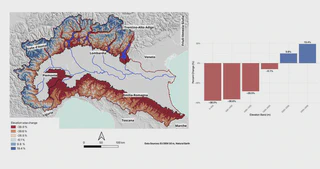Three decades of snow water equivalent dynamics in the Po River Basin
Sep 14, 2025· ·
0 min read
·
0 min read
John Mohd Wani
 Image credit: John Mohd Wani
Image credit: John Mohd WaniAbstract
Seasonal snowpack is a key component of the mountain cryosphere, acting as a vital natural reservoir that regulates runoff downstream in snow-fed basins. In mid- and low-elevation mountain regions such as the European Alps, snow processes, such as accumulation and melt are highly sensitive to climate change, having direct implications for hydrological forecasting and water availability. In this study, we analyse a 30-year (1991–2020) long dataset of snow water equivalent (SWE) in the Po River district, Italy, encompassing portions of the Alps and Apennines. The dataset is available at a 500×500 m spatial resolution and at a daily temporal scale. The data was generated using the “J-Snow” modelling framework, which integrates the physically based GEOtop model with in-situ snow height observations and remotely sensed snow cover products (e.g., MODIS). The Po River basin, the largest in Italy, is among the most sensitive hydrological basins in Europe and has experienced frequent droughts, including a severe snow drought event in 2022. Therefore, these kinds of long-term spatial datasets help to monitor and analyse the spatial and temporal changes in the SWE and provide vital insights for addressing the snow drought alerts in the study region. We computed key snow phenology metrics and their trends, such as snow persistence, first snow date (FSD), snow disappearance date (SDD), peak SWE, peak SWE timing, and regional snow line elevation. Our initial results show that the long-term basin-wide SWE volume equals 3.34 Gm³ and a mean snow-cover area of 15,471 km². Additionally, elevation-wise analysis of snow phenology metrics show that the most pronounced changes occur below 2000 m a.s.l. Changes in snow-water storage start, snowmelt timing, and its variability can directly affect the water availability in snow-fed basins, with significant implications for both ecosystems and human populations.
Date
Sep 14, 2025 12:00 AM — Sep 18, 2025 12:00 AM
Event
Location
Innsbruck, Austria